Ruth Ellen Gruber's Blog, page 20
June 8, 2011
Publication -- Rudi Klein's magnum opus on Hungarian synagogues is out!
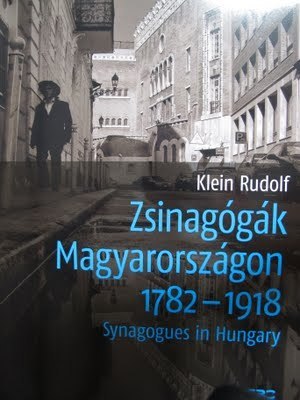
By Ruth Ellen Gruber
My friend Rudi Klein's magisterial and encyclopedic book on Hungarian synagogues has been published, adding an extraordinarily rich resource to anyone interested in architecture and architectural history as well as in the development of Jewish art and lifestyle from the late 18th century to World War I. A big Mazel Tov to him!
The hefty tome -- it runs more than 670 pages and weighs in at about 4 kilograms -- traces the development of synagogue architecture in the historic Hungarian and Hapsburg lands of central Europe. Klein describes several hundred synagogues -- including destroyed buildings as well as buildings that still exist, classifying and commenting on their "genealogy, typography and architectural significance."
Hundreds of gorgeous and informative photographs, drawings, diagrams, old postcards, plans and other images illustrate the text -- most contemporary pictures were taken by Klein himself. The main text is in Hungarian, but there is a lengthy summary in English -- and all of the illustrations bear English captions. Here are a few sample pages:
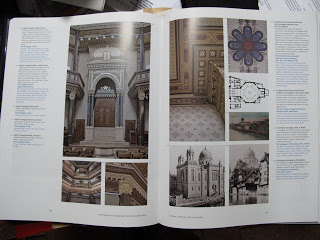
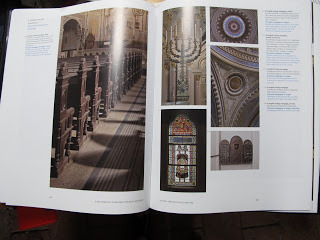
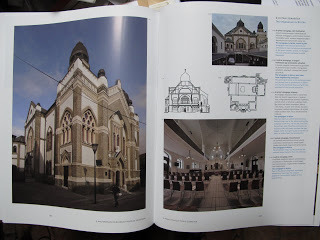
Klein breaks down the architectural typology into range of types
-- Simple "peasant cottage-type synagogues"
-- Burgher house-type synagogues
-- Protestant church-type synagogues
-- "Solomon's Temple-type synagogues" with battlements, lunette, or pediment
-- Factory Hall-type synagogues
-- Catholic church-type synagogues
-- Byzantine church-type synagogues
-- Palace-type synagogues
In addition to detailed descriptions of exemplary buildings, he includes a comparative catalogue of thumb nail pictures illustrating all the synagogues of each type.
It is a landmark work, the fruit of many years of archival and on-site research, which will be of great value to a wide audience -- from scholars and students to, well, tourists. (It amplifies, corrects, broadens and expands some of the material included in a book on Hungarian synagogues by Aniko Gazda, published in 1989, which I used as the guide for my first foray around Hungary looking for synagogues -- in 1990, as well as for other trips.)
Unfortunately, the sheer size (and weight) of Rudi's book, not to mention the price (approx $80) -- plus the fact that it is at this point only available in Hungary -- limit the possibilities..... I very much hope that a digital version will be published so that the wealth of material can be easily obtained by a broad international readership.
Published on June 08, 2011 03:25
June 2, 2011
Hungarian Yiddishe Mamma Mia
 Yum. Photo (c) Ruth Ellen Gruber
Yum. Photo (c) Ruth Ellen GruberBy Ruth Ellen Gruber
I'm on the road -- this week in Poland, and last week in Budapest, where I came across (but didn't sample) this new restaurant in Gozsdu Udvar, the wonderful series of linked courtyards in the 7th District, between Kiraly and Dob streets, that was renovated recently with debatable results.....It's not clear if it's Italian Jewish (which I rather doubt), or comfort food with an attitude (which may be more like it.)
Gozsdu Udvar will be part of the scene of the Judafest festival on Sunday -- food, music, stands, etc in the old downtown Jewish quarter.
I'll miss this, as I'm heading to Krakow (from Sanok, in the far southeast tip of Poland, where I've been all week) in order to take in the "Night of the Synagogues" festival Saturday night, when all seven of the historic synagogues in the Kazimierz district will be open to the public, with lots of programming, until 2 a.m.
There's a lot to report from my trip -- but it will come in dribs and drabs... I haven't had much time (or a constant internet connection) to sort out photos and stories.
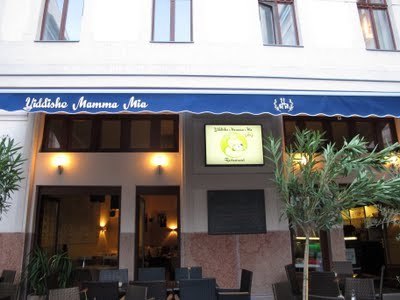 Photo (c) Ruth Ellen Gruber
Photo (c) Ruth Ellen Gruber
Published on June 02, 2011 14:32
Yiddish Mamma Mia
 Yum. Photo (c) Ruth Ellen Gruber
Yum. Photo (c) Ruth Ellen GruberBy Ruth Ellen Gruber
I'm on the road -- this week in Poland, and last week in Budapest, where I came across (but didn't sample) this new restaurant in Gozsdu Udvar, the wonderful series of linked courtyards in the 7th District, between Kiraly and Dob streets, that was renovated recently with debatable results.....It's not clear if it's Italian Jewish (which I rather doubt), or comfort food with an attitude (which may be more like it.)
Gozsdu Udvar will be part of the scene of the Judafest festival on Sunday -- food, music, stands, etc in the old downtown Jewish quarter.
I'll miss this, as I'm heading to Krakow (from Sanok, in the far southeast tip of Poland, where I've been all week) in order to take in the "Night of the Synagogues" festival Saturday night, when all seven of the historic synagogues in the Kazimierz district will be open to the public, with lots of programming, until 2 a.m.
There's a lot to report from my trip -- but it will come in dribs and drabs... I haven't had much time (or a constant internet connection) to sort out photos and stories.
 Photo (c) Ruth Ellen Gruber
Photo (c) Ruth Ellen Gruber
Published on June 02, 2011 14:32
May 27, 2011
Romania -- Radauti synagogue restoration moving forward
By Ruth Ellen Gruber
Edgar Hauster posts on his blog that the renovation of the synagogue in Radauti is moving ahead -- the restoration of the facade is nearing completion.... he has posted a picture of the exterior of the building, taken a few days ago. According to Hauster, the work is being carried out with funding from the Federation of Romanian Jewish Communities, as well as from the town itself.
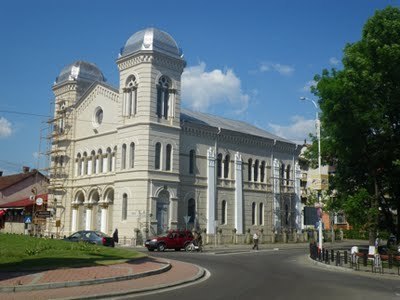 Radauti synagogue restored. Photo: Edgar Hauster, http://hauster.blogspot.com/
Radauti synagogue restored. Photo: Edgar Hauster, http://hauster.blogspot.com/
Edgar Hauster posts on his blog that the renovation of the synagogue in Radauti is moving ahead -- the restoration of the facade is nearing completion.... he has posted a picture of the exterior of the building, taken a few days ago. According to Hauster, the work is being carried out with funding from the Federation of Romanian Jewish Communities, as well as from the town itself.
 Radauti synagogue restored. Photo: Edgar Hauster, http://hauster.blogspot.com/
Radauti synagogue restored. Photo: Edgar Hauster, http://hauster.blogspot.com/
Published on May 27, 2011 10:55
Romania -- Dorin Fraenkel 1945-2011
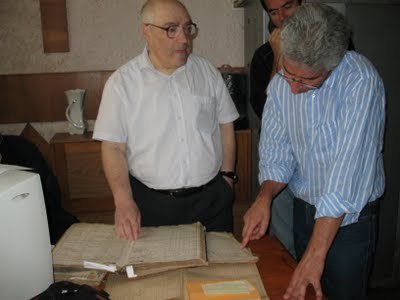 September 2009. Photo (c) Ruth Ellen Gruber
September 2009. Photo (c) Ruth Ellen GruberBy Ruth Ellen Gruber
I was shocked and deeply saddened to learn today of the sudden death of Dorin Fraenkel, in Radauti. Dorin, who was 66, apparently suffered a heart attack on Wednesday. The writer Edgar Hauster spent a couple of days with him this past week and says there was no indication that he was unwell.
Dorin was a kind and charming man, and the repository of a wealth of knowledge about Radauti, its Jews and its Jewish history. He helped many people delve into family history and knew the ins and outs of dusty research.....I met him in 2009, when I traveled to Radauti with three of my cousins -- he took us to the town archives and pored over old record books to find information about our ancestors.
It is only now, after the news of his death, that I have found out that he was a accomplished musician, who wrote music and played the piano; according to YouTube he uploaded this piece not long after our visit to Radauti. May his soul be bound up in the bond of life.
Published on May 27, 2011 10:18
May 25, 2011
Poland -- Home of WW2-era Warsaw Zoo director who sheltered Jews to become a museum
by Ruth Ellen Gruber
The two-story home where the Warsaw Zoo's director Jan Żabiński and his wife Antonina sheltered about 300 Jews and others from the Nazis during World War II is to become a small museum dedicated to the couple and their heroism.
According to a report on Polish radio, the museum will be opened in the fall.
The Zabinskis were recognized by Yad Vashem as Righteous Among Nations in 1965.
Zabinski was allowed to enter the Warsaw Ghetto as a municipal official. There he connected with people he knew and, according to testimony on the Yad Vashem web site, helped get Jews "over to Aryan side, provided them with indispensable personal documents, looked for accommodations, and when necessary hid them at his villa or on the zoo's grounds."
With the Zabinskis' help, many Jews found temporary shelter in the zoo's abandoned animal cells, until, the web site puts it, "they were able to relocate to permanent places of refuge elsewhere." In addition, the couple, aided by their son, sheltered nearly a dozen Jews in their two-story private home on the zoo's grounds.
According to the Polish radio report, when Nazis officials visited, Antonina Zabinska would play a certain piece of music on the family piano to warn Jews in the house that they should hide.
The Yad Vashem web site describes Zabinski as an active member of the Polish underground Armia Krajowa (Home Army), who
The Zabinskis' story was recounted in the 2007 book by Diane Ackerman, "The Zookeeper's Wife."
Publishers Weekly wrote:

The two-story home where the Warsaw Zoo's director Jan Żabiński and his wife Antonina sheltered about 300 Jews and others from the Nazis during World War II is to become a small museum dedicated to the couple and their heroism.
According to a report on Polish radio, the museum will be opened in the fall.
The Zabinskis were recognized by Yad Vashem as Righteous Among Nations in 1965.
Zabinski was allowed to enter the Warsaw Ghetto as a municipal official. There he connected with people he knew and, according to testimony on the Yad Vashem web site, helped get Jews "over to Aryan side, provided them with indispensable personal documents, looked for accommodations, and when necessary hid them at his villa or on the zoo's grounds."
With the Zabinskis' help, many Jews found temporary shelter in the zoo's abandoned animal cells, until, the web site puts it, "they were able to relocate to permanent places of refuge elsewhere." In addition, the couple, aided by their son, sheltered nearly a dozen Jews in their two-story private home on the zoo's grounds.
According to the Polish radio report, when Nazis officials visited, Antonina Zabinska would play a certain piece of music on the family piano to warn Jews in the house that they should hide.
The Yad Vashem web site describes Zabinski as an active member of the Polish underground Armia Krajowa (Home Army), who
participated in the Polish uprising in Warsaw of August and September 1944. Upon its suppression, he was taken as a prisoner to Germany. His wife continued his work, looking after the needs of some of the Jews left behind in the ruins of the city. Jan wrote in his own testimony explaining his motives: "I do not belong to any party, and no party program was my guide during the occupation... I am a Pole – a democrat. My deeds were and are a consequence of a certain psychological composition, a result of progressive-humanistic upbringing, which I received at home as well as in Kreczmar High School. Many times I wished to analyze the causes for dislike for Jews and I could not find any, besides artificially formed ones."
The Zabinskis' story was recounted in the 2007 book by Diane Ackerman, "The Zookeeper's Wife."
Publishers Weekly wrote:
Using Antonina's diaries, other contemporary sources and her own research in Poland, Ackerman takes us into the Warsaw ghetto and the 1943 Jewish uprising and also describes the Poles' revolt against the Nazi occupiers in 1944. She introduces us to such varied figures as Lutz Heck, the duplicitous head of the Berlin zoo; Rabbi Kalonymus Kalman Shapira, spiritual head of the ghetto; and the leaders of Zegota, the Polish organization that rescued Jews. Ackerman reveals other rescuers, like Dr. Mada Walter, who helped many Jews pass, giving lessons on how to appear Aryan and not attract notice. Ackerman's writing is viscerally evocative, as in her description of the effects of the German bombing of the zoo area: ...the sky broke open and whistling fire hurtled down, cages exploded, moats rained upward, iron bars squealed as they wrenched apart.
Published on May 25, 2011 14:58
Ukraine -- Jewish Travel Web Site and Tours, etc
 Fortresslike 16th century synagogue building in Sharhorod, Ukraine. Photo (c) Ruth Ellen Gruber
Fortresslike 16th century synagogue building in Sharhorod, Ukraine. Photo (c) Ruth Ellen GruberBy Ruth Ellen Gruber
People are always asking me for advice on "traveling Jewish" in Ukraine -- arranging trips and tours, finding places, accommodation, information, etc.
A new (or newish) web site and organization, "JUkraine" may now be the answer.
I just came across the web site -- jukraine.com -- and it looks at if it will be very helpful.
I hope so! Ukraine is a huge country, rich with fascinating Jewish heritage sites and also home (in some places) to active Jewish communities. To date, my chapter on Ukraine in Jewish Heritage Travel is one of the only Jewish guides to the country -- but it only minimally scratches the surface.
Published on May 25, 2011 09:07
Poland -- Politics and Shake-ups at the Jewish History Museum in Warsaw.....
By Ruth Ellen Gruber
The Forward runs a fascinating piece about the shake-up at the top of the Museum of the History of Polish Jews in Warsaw that saw the forced resignation of longtime director Jerzy Halbersztadt, one of the creators of the institution.
The museum -- nearly 20 years in development -- is now scheduled to open in 2013. Its building is largely complete, but work is still going on regarding the exhibits and installations. The Forward notes that Halberszadt's departure under pressure "is provoking concern about the future of the ambitious project, which aims to preserve a legacy of 1,000 years of Jewish life in Poland."
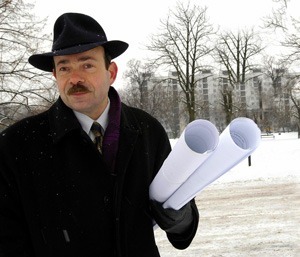 Photo: Handhouse Studio
Photo: Handhouse Studio

The Forward runs a fascinating piece about the shake-up at the top of the Museum of the History of Polish Jews in Warsaw that saw the forced resignation of longtime director Jerzy Halbersztadt, one of the creators of the institution.
The museum -- nearly 20 years in development -- is now scheduled to open in 2013. Its building is largely complete, but work is still going on regarding the exhibits and installations. The Forward notes that Halberszadt's departure under pressure "is provoking concern about the future of the ambitious project, which aims to preserve a legacy of 1,000 years of Jewish life in Poland."
 Photo: Handhouse Studio
Photo: Handhouse StudioJerzy Halbersztadt, the museum's project director since its conception in 1996, announced his resignation at an April 22 press conference after months of indecision by Poland's Ministry of Culture about renewing his five-year contract. Halbersztadt's contract had lapsed five months earlier.
Since Halbersztadt's announcement, the museum has been run by his former deputy, Agnieszka Rudzińska, while the institution's trustees search for a successor.
Halbersztadt's unexpected departure came about as a result of repeated clashes with the Ministry of Culture over what he regarded as inadequate funding for the museum's day-to-day operations. But in a March statement to the press, Culture and National Heritage Minister Bogdan Zdrojewski said that Halbersztadt was unable to cooperate with others and that he believed it was time for the project to have a new director.
Halbersztadt told the Forward that after his most recent contract lapsed, "They reduced my authority as director. I was unable to make any strategic financial decisions and even a [lost my] right to contract staff."
Read more: http://forward.com/articles/138075/#ixzz1NNOS0vpM
Published on May 25, 2011 07:59
May 24, 2011
Poland -- Krakow's Night of the Synagogues program
Here's the program (in Polish) for the Night of the Synagogues in Krakow, June 4:
For more information, click HERE
For more information, click HERE
Published on May 24, 2011 09:25
May 21, 2011
Krakow -- "Night of the Synagogues" coming up
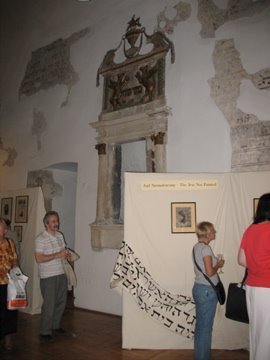 An exhibition in High Synagogue. Photo (c) Ruth Ellen Gruber
An exhibition in High Synagogue. Photo (c) Ruth Ellen GruberBy Ruth Ellen Gruber
The night of June 4 will be the "Night of the Synagogues" in Krakow, according to the newspaper Gazeta Wyborcza. All seven historic synagogues in the old Jewish quarter, Kazimierz -- the gothic Old Synagogue, the Remuh Synagogue, the High Synagogue, the Kupa Synagogue, the Izaak Synagogue, the Popper synagogue and the Tempel synagogue -- will remain open and will feature concerts, performances and other events.
According to the article, "Instead of klezmer bands in the Tempel synagogue you can listen to contemporary Israeli rock music." There will be a Dj in the Old Synagogue and also various art workshops.
The full schedule of events will be available Monday.
Published on May 21, 2011 12:57




